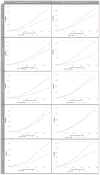Secondary bladder and colorectal cancer after treatments for prostate cancer: A population based study
- PMID: 38351647
- PMCID: PMC10904975
- DOI: 10.1002/cam4.6922
Secondary bladder and colorectal cancer after treatments for prostate cancer: A population based study
Abstract
Background: Prostate cancer (PCa) patients receiving radiotherapy may be predisposed to secondary malignancies. This study aimed to determine the association between PCa treatments, including radical prostatectomy (RP), external beam radiation therapy (EBRT), brachytherapy (BT) and androgen deprivation therapy (ADT); and secondary bladder and colorectal cancer.
Methods: A cohort study was constructed using Quebec administrative databases (Med-Echo and RAMQ). Included men were diagnosed and treated for PCa between 2000 and 2016. Patients with bladder or colorectal cancer prior to PCa were excluded. Follow-up ended at the earliest of the following: incidence of bladder or colorectal cancer, death, or December 31, 2016. EBRT, BT, EBRT+ADT, RP + ADT or ADT only were compared individually to RP. The incidence of secondary bladder and colorectal cancer were computed. Inverse probability of treatment weighting (IPTW) based on a propensity score was used to control for potential confounding. IPTW-Cox proportional hazards models were used.
Results: A significant association was found between secondary bladder cancer and EBRT (HR: 1.84, 95%CI: 1.60;2.13), and also EBRT+ADT (HR: 2.08, 95%CI: 1.67;2.56), but not with BT (HR: 1.36, 95%CI: 0.68;2.74). Secondary colorectal cancer was significantly associated to either EBRT (HR: 1.36, 95%CI: 1.21;1.53); or BT (HR: 2.46, 95%CI: 1.71;3.54). The association between ADT alone and both secondary cancers was also significant (HR: 1.98, 95%CI: 1.69;2.31 and HR: 1.69, 95%CI: 1.49;1.92, respectively).
Conclusions: Compared to PCa patients undergoing RP, the secondary bladder cancer was associated with EBRT, ADT, alone or in combination. The secondary colorectal cancer was also associated with receiving either EBRT, BT or ADT.
Keywords: androgen deprivation therapy; bladder cancer; brachytherapy; colorectal cancer; external beam radiation therapy; prostate cancer; secondary malignancies.
© 2024 The Authors. Cancer Medicine published by John Wiley & Sons Ltd.
Conflict of interest statement
None of the contributing authors have any conflicts of interest.
Figures
Similar articles
-
Assessing the role of external beam radiation therapy in combination with brachytherapy versus brachytherapy alone for unfavorable intermediate-risk prostate cancer.Brachytherapy. 2022 May-Jun;21(3):317-324. doi: 10.1016/j.brachy.2021.12.008. Epub 2022 Feb 3. Brachytherapy. 2022. PMID: 35123889 Free PMC article.
-
Assessing the impact of brachytherapy boost and androgen deprivation therapy on survival outcomes for patients with unfavorable intermediate-risk prostate cancer patients treated with external beam radiotherapy.Brachytherapy. 2022 Sep-Oct;21(5):617-625. doi: 10.1016/j.brachy.2022.04.001. Epub 2022 May 28. Brachytherapy. 2022. PMID: 35641370 Free PMC article.
-
Interplay Between Duration of Androgen Deprivation Therapy and External Beam Radiotherapy With or Without a Brachytherapy Boost for Optimal Treatment of High-risk Prostate Cancer: A Patient-Level Data Analysis of 3 Cohorts.JAMA Oncol. 2022 Mar 1;8(3):e216871. doi: 10.1001/jamaoncol.2021.6871. Epub 2022 Mar 17. JAMA Oncol. 2022. PMID: 35050303 Free PMC article. Clinical Trial.
-
Benefits and Risks of Primary Treatments for High-risk Localized and Locally Advanced Prostate Cancer: An International Multidisciplinary Systematic Review.Eur Urol. 2020 May;77(5):614-627. doi: 10.1016/j.eururo.2020.01.033. Epub 2020 Mar 4. Eur Urol. 2020. PMID: 32146018
-
Brachytherapy boost (BT-boost) or stereotactic body radiation therapy boost (SBRT-boost) for high-risk prostate cancer (HR-PCa).Cancer Radiother. 2021 Jun;25(4):400-409. doi: 10.1016/j.canrad.2020.11.004. Epub 2021 Jan 18. Cancer Radiother. 2021. PMID: 33478838
Cited by
-
[Secondary bladder cancer following radiation therapy for prostate cancer: a systematic review and meta-analysis of incidence and outcomes].Urologie. 2025 Jun;64(6):584-587. doi: 10.1007/s00120-025-02592-8. Epub 2025 Apr 29. Urologie. 2025. PMID: 40298971 German. No abstract available.
-
Role of sex steroids in colorectal cancer: pathomechanisms and medical applications.Am J Cancer Res. 2024 Jul 15;14(7):3200-3221. doi: 10.62347/OEBS6893. eCollection 2024. Am J Cancer Res. 2024. PMID: 39113870 Free PMC article. Review.
-
Second primary cancers and hormonal therapies for prostate cancer: A nested case-control study.Fundam Clin Pharmacol. 2025 Apr;39(2):e70004. doi: 10.1111/fcp.70004. Fundam Clin Pharmacol. 2025. PMID: 40096844 Free PMC article.
-
Incidence, Risk and Trends of Multiple Primary Cancers in Patients With Colorectal Cancer: Evidence From the South Australian Cancer Registry.Cancer Med. 2025 Jun;14(11):e70984. doi: 10.1002/cam4.70984. Cancer Med. 2025. PMID: 40444502 Free PMC article.
-
Tracing the Evolution of Sex Hormones and Receptor-Mediated Immune Microenvironmental Differences in Prostate and Bladder Cancers: From Embryonic Development to Disease.Adv Sci (Weinh). 2025 Apr;12(13):e2407715. doi: 10.1002/advs.202407715. Epub 2025 Feb 25. Adv Sci (Weinh). 2025. PMID: 40007149 Free PMC article. Review.
References
-
- LeBlanc AG, Demers A, Shaw A. Recent trends in prostate cancer in Canada. 2021. https://www150.statcan.gc.ca/n1/pub/82‐003‐x/2019004/article/00002‐eng.htm - PubMed
-
- Canadian Cancer Society's Advisory Committee on Cancer Statistics . Canadian Cancer Statistics. 2022.
Publication types
MeSH terms
Substances
Grants and funding
LinkOut - more resources
Full Text Sources
Medical


